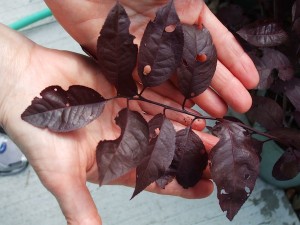
Leaf cutter bees use disks cut from leaves of many plants, including Baptisia, to make individual cells in their nest. (C) Photo courtesy V. Schneider
V. S. of Indianapolis asks what could be eating her false indigo (Baptisia).
“I cannot find any sign of an insect on the plants, but it looks like holes have been made in the leaves with a paper punch. They are small, round holes,” she wrote in an e-mail.
The reader describes the damage made by the non-aggressive leaf-cutter bee (Megachile), an important native insect for pollinating vegetables, fruits and flowers. It is slightly smaller and darker than a honeybee.
“These bees are so effective at pollination that alfalfa seed producers buy masses of bee pupae so that adults are available to pollinate the alfalfa crop,” wrote Purdue University entomologist Tom Turpin in a 2007 “On Six Legs” publication.
Most of us are familiar with honeybees and bumble bees, which live in colonies in hives. All other bees are solitary bees, including the leaf cutter bee, orchard mason bee and carpenter bee.
Solitary females lay eggs on mounds of ready-to-eat pollen or honey, in the ground, a hole in wood or hollow-stemmed plant.
“The leaf-cutter bees cut circles out of plant leaves to partition their nests into individual cells. Solitary bees do the child rearing as a single parent,” Turpin said. “But they get the job done and, in the process, contribute to fruit and berry production in many home gardens.”
No pesticides are labeled for use on leaf cutter bees, so none is recommended. The damage to plants is aesthetic, and outweighed by the little bee’s benefits.
